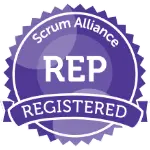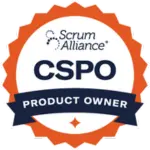

Emerging job or skillset needed for the Emerging Global Workforce. (Source: World Economic Forum: https://www.scrumalliance.org/get-certified/product-owner-track/certified-scrum-product-owner)
94% Said they would recommend others to earn the CSPO certification (Source: LinkedIn: https://www.scrumalliance.org/get-certified/product-owner-track/certified-scrum-product-owner)
100% Chance to expand your career opportunities across all industry sectors.
Product Manager/Product Owner
Business Analyst/Senior Business Analyst
Scrum Professional
Software Developers/Software Resters
Quality Assurance Professional
Provides transparency to stakeholders on progress toward goals.
Gathers information or insights from stakeholders.
Maintains authority over the Product Backlog while working collaboratively with Developers and stakeholders.
Creates a Sprint Goal with a Scrum Team.
Define the relationship between a product vision and a Product Goal.
Creates a Product Backlog that supports the achievement of a Product Goal.
There are no prerequisites to take the Certified Scrum Product Owner (CSPO®) training online. However, it will be beneficial for those who have the aptitude and curiosity to meet the customers’ needs and expectations.
Enroll on the CSPO course with iZenBridge.
Attend our CSPO session with the expert CSTs.
Receive an email from Scrum Alliance.
Log in to your Scrum Alliance’s dashboard.
Complete the survey of Scrum Alliance.
Accept the License & Agreement from Scrum Alliance.
Understand and describe the fundamentals of the Product Owner Role while working with stakeholders and the development teams.
Determine and evaluate the product strategy, create a prioritized product roadmap and release planning.
Analyse and simplify customer research and product delivery.
Apply the opportunities to test assumptions during product discovery, product development, and delivery.
Understand the relationship between the outcome and output with the Product Owner’s responsibility to maximize value.
CSPO Online Training with 100% Assured Scrum Alliance’s CSPO certification
You will earn 16 PDUs and 30 SEUs
2-year membership with Scrum Alliance
Continuous learning and support to advance your Scrum understanding
Full money back if you don’t like or are unable to attend the class
1. Understand the Scrum Flow, the core components of the Scrum framework, and the Scrum vocabulary
2. Understand the principles/legs of empirical process control
3. Understand the work culture Scrum creates
1. Understand the scope of the Product Owner role in detail
2. Understand the scope of the ScrumMaster role at a high level
3. Understand the scope of the Team role at a high level
4. Understand why there is no project manager and no agile product manager
1. Understand the importance of having the product vision as an overarching goal galvanizing the entire Scrum team
2. Understand the desirable qualities of the vision
3. Understand how the vision can be shaped
4. Understand the importance of carrying out just enough prep work
5. Understand the relationship between vision and product roadmap
1. Understand the different estimation levels in Scrum
2. Understand that the accuracy of an estimate is more important than the precision of the estimate
3. Understand that estimates of size and duration can be done separately
4. Understand the impact of pressuring team members to provide low estimates
5. Understand the difference between estimating and committing
1. Understand what the product backlog is (and is not)
2. Understand product backlog grooming
1. Understand the importance and benefits of prioritizing the product backlog
2. Understand the implications of saying everything is mandatory
3. Understand who should have input into prioritization decisions
4. Understand that proper prioritization of a product backlog is based on multiple factors
5. Understand and know how to apply formal approaches to prioritizing (i.e., beyond just “gut feel” or intuition)
6. Understand how much latitude to give a team in adjusting the sequence of work
1. Understand the goal of release management
2. Understand that planning is adaptive, iterative, and collaborative
3. Understand why quality is frozen and the concept of technical debt
4. Understand why software should be released early and frequently
5. Understanding and measuring velocity
6. Understand the release burndown chart
7. Understand how a release plan can help forecast the future
1. Understand the product owner’s role in the Scrum meetings
2. Understand how the Product Owner and Development Team collaborate during the Sprint
3. Understand what team commitment means
4. Understand why sprints are timeboxed and protected
5. Understand the concept of sustainable pace

Trained 5000+ professionals worldwide

Facilitated 100+ virtual sessions

Beyond just the syllabus. Interactive discussions and group activities

Complete career path guidance in Scrum and Agile

1000+ videos on our YouTube channel

55,000+ subscribers are getting the benefit

500+ enrollments every month
A Product Owner is a mini CEO with complete ownership of a product and the value it delivers to the end customer. A Product Owner’s role is to maintain and prioritize product backlogs, interact with the stakeholders for feedback on a product, and collaborate between the team and other stakeholders for effective on-time delivery of the product under development.
CSPO® – Certified Scrum Product Owner® is a credential offered by Scrum Alliance®. A Product owner understands the customers who buy the product, end-users who use the product, and sponsors who invest in the product and prioritizes the work done. If you aspire to become a Product Owner or want to coach Product Owners as a Scrum Master or as an Agile coach, then you should do the Certified Scrum Product Owner course.
The CSPO course covers details related to the Product Owner’s role, like:
– How to look at the product backlog?
– How to identify the right requirement for the product?
– How to set a vision for the product?
– How to communicate things with various stakeholders and development teams?
It improves your overall understanding of the complete Product Owner’s role. So, professionals who want to become great Product Owners should do it.
As per Scrum Alliance, there is no examination required to get the CSPO certificate after attending the training. However, you will receive the certificate based on your active participation and trainer evaluation in the CSPO live training session.
As per Scrum Alliance, the CSPO certificate is valid for two years. After two years, you can renew your Agile Scrum Product Owner certification by earning 20 SEUs.
After the Scrum Alliance’s CSPO training, we provide you with access to our three complementary online programs against which you will earn 14 SEUs. When you plan to renew the CSPO certificate after two years, you will claim these 14 SEUs (from our complimentary programs) & we will further assist you to earn six more SEUs, and you are done with 20 SEUs for renewal (14+6=20). No need to worry about the renewal as we are always available to support our clients.
| Features | Certified Scrum Product Owner | SAFe Product Owner |
| Exam | No | Yes |
| Training | Mandatory | Mandatory |
| Community Membership | 2 years | 1-year |
| Certification fee | 27000 for exam and training both | 50000 Approx. For exam and training both |
| Branding | Yes | Yes |
CSPO® – Certified Scrum Product Owner® is a stepping stone to getting started in project management. If you are looking to enhance your skills and credibility to lead product development initiatives, then the Certified Scrum Product Owner Program is for you. This CSPO scrum online training will teach you the competencies of a successful Product Owner. You will learn how to produce efficiently without compromising quality, how to handle a product together with Scrum teams, how to order the backlog of the product while ensuring that the product is delivered, and so on.
A-CSPO® – Advanced Certified Scrum Product Owner® is designed for Certified Scrum Product Owner® (CSPO®) who wish to take their Scrum Product Owner skills to the next level. As a Product Owner, you will work directly with the business to gain product knowledge, make the decisions related to prioritizing the product backlog items, and also help in providing the vision of the product. If you are already a Certified Scrum Product Owner, the next step in your Agile journey is to achieve your Advanced Certified Scrum Product Owner (A-CSPO) certification. As an A-CSPO, you will learn how to handle multiple business initiatives from competing stakeholders, order and express items for Product Backlog, define a clear product vision, communicate effectively to achieve alignment with different stakeholder groups, recognize the necessary possibilities and avoid wasting time, define and validate business value, enhance your credibility as a product expert and so on.
CSPO® – If you want to start your Agile and Scrum Journey by working with Small Agile teams for effective product development, then CSPO is for you. Through this course, you will understand the developing product vision, prioritising product backlogs, and optimising value to delight the customer. So, professionals who want to become great Product Owners should do it.
SAFe® POPM – If you want to understand the role of a Product Management and Product Owner at a SAFe enterprise level, then this course is for you. Through this course, you will explore the role of the Product Management and Product Owner, prepare and participate in PI planning, and ensure smooth execution of Program and Team Backlogs to deliver the maximum business value at scale. So, if your organization is already using SAFe, this is one of the best career investments.
However, to know more, check out our blog SAFe® POPM vs CSPO®
Yes, unlike earlier, now you can do the online training for CSPO® certification
| Skill | Criticality |
| Emotional intelligence | Critical |
| Collaborative skills | Critical |
| motivating teams | Moderately critical |
| knowledge of Scrum | Critical |
| Ability to work and empathize with customers | Very Critical |
| Ability to communicate difficult decisions at all levels | Very Critical |
| Ability to work within an organization to remove impediments | Moderately critical |
| Ability to say no | Critical |
| Business skills | Critical |
| Knowledge of the complete product life cycle | Critical |
| Ability to apply the 80/20 rule | Very Critical |
| Negotiation skills | Very critical |
| Ability to influence | Very Critical |
| Domain expertise | Very Critical |
| Conflict management | Moderately Critical |
| Ability to make decisions | Very critical |
Here is the comprehensive list of Product Owner anti-patterns that a Product Owner should understand and avoid –
| Scrum Anti-Pattern (Product Owner) | Explanation |
| Oversized product backlog | The product backlog contains more items than the Scrum team can deliver within three to four sprints. |
| Incorrect product Backlog | Product Owner Copies items from requirement documents without consulting the Scrum team. |
| The weak Product Owner | The Product Owner does not have the ability to say NO. |
| Prioritization by proxy | Other stakeholders are prioritizing the product backlog, and PO is just their proxy with little power. |
| No One is the Product Owner | When multiple stakeholders are defining and refining the requirements, the team gets confusing decisions and instructions. |
| “I know everything” Product Owner | The PO does not involve stakeholders or subject matter experts in the refinement process, and probably not even the Scrum team. |
| Role Confusion | The Product Owner is confused about his role and tries to be both Scrum Master and Product Owner at the same time. |
| Lack of interaction | Lacks interaction with the team, mostly dependent on tools like Jira for interaction with the team. |
| Not questioning Requirements | Inserting everything from the requirement document without questioning the value for the end-user. |
| Not understanding the risk | Add items without a valid understanding of business risks |
| The lack of a sprint goal | The Product Owner cannot provide a sprint goal, or the chosen sprint goal is flawed. |
| The pushy Product Owner | Pushes the development team to take on more tasks than it could realistically handle using his previous experience and learning of team velocity |
| Playing with the “definition of done” | Changing DOD by squeezing in some last-minute user stories that do not meet the definition of Done |
| The absent Product Owner | A Product Owner should be readily available for immediate clarification. His inability to respond quickly will create a risk of the Scrum team missing their sprint goal. |
| Cannot let go of product backlog items once they become sprint backlog items | Increasing the scope of a user story or modifying the acceptance criteria at the last moment without consulting the Scrum team. |
| The selfish Product Owner | There is no 1 in the team. It’s not his or her accomplishments, it’s team accomplishments. The Product Owners should not take credit for team achievements. |
| The unapproachable, the broadcasting Product Owner | The Product Owner is not accepting feedback from the customers and the stakeholders. |
Three leading organizational contexts affect a Product Owner’s role –
A product owner can take the following distinct decision-making approaches. Here are their pros and cons.
| Decision-making approach | Pros | Cons |
| Product Owner decides and informs the team |
|
|
| Product Owner consults the Development Team and/or stakeholders and then decides |
|
|
| Product Owner delegates a decision |
|
|
A Product Owner is a natural facilitator. The role involves dealing with multiple stakeholders, often with conflicting interests. The Product Owner has to perform the role of a neutral facilitator in the entire discussion; his focus should be on getting unambiguous and non-conflicting information out of a discussion between various stakeholders.
As a Product Owner, you need to be a master facilitator who can bring the best out of a team and enhance collaboration. Here is a list of the most important facilitation techniques for Product Owners –
Affinity Grouping –
Affinity Grouping is a brainstorming method in which participants organize their ideas and identify common themes. A Product Owner can use Affinity grouping to club similar product ideas of feature requests; it helps them refine a user story.
Follow these steps to create Affinity grouping in your next Product Discussion meeting –
Dot Voting
Dot Voting is another group discussion technique used by Product Owners to find preferences. The Product Owners can use this technique to prioritize a feature list or a list of story items. Follow the steps below to use the dot voting technique –
Fist to five
Fist to five is another popular brainstorming technique used by Product Owners to help achieve consensus among teams. Follow the steps below to use this technique –
Open-ended Questions
The product backlog is owned, managed, and prioritized by the Product Owner. He may take some help from the Scrum team and discuss ideas, but primary responsibility stays with the Product Owner.
Scrum does not recommend any role of a Product Owner. The complete product backlog and stakeholder interaction are owned by the Product Owner. But in an Enterprise Agile Environment, organizations have a Product Manager role that focuses on high-level requirements and interacts with the external stakeholders.
Difference between Product Owner and Product Manager
| Product Owner | Product Manager |
| Converts high-level requirements into user stories. | Manages high-level requirements. |
| Writes story level Acceptance criteria and Definition of done. | Writes high-level acceptance criteria. |
| Interacts with internal stakeholders. | Interacts with external stakeholders. |
| Focus on immediate delivery and product value. Attends Scrum meetings, retrospectives, product demos, etc. | Has a long-term vision for the product, and interacts with sales, marketing and other external stakeholders. |
Yes, the Certified Scrum Product Owner cost of certification is included in the course fee.
There is no defined level of experience after which you can consider going for a PO role. Ideally, after 3-4 years of experience, you might be able to handle the challenges which a Product Owner role offers. A Product Owner needs to be a tough negotiator, team player and a great collaborator to succeed. Domain expertise and understanding of the Scrum framework are also critical for success.
You will earn 16 PDUs and 30 SEUs after the Certified Scrum Product Owner training program.
No, this workshop provides you with the membership of Scrum Alliance for two years.
No, on successful completion of the course, you will receive a Certified Scrum Product Owner® (CSPO®) Certificate.
Yes, the Certified Scrum Product Owner Certification training cost is included in the course fee.
You can go for advanced certificates like CSP® or PMI-ACP®. We also provide support in getting your advanced certificates like CSP® or PMI-ACP®.
As per Scrum Alliance, there is no examination required to get the CSPO certificate after attending the training. However, you will receive the certificate based on your active participation and trainer evaluation in the CSPO live training session.
CSPO® – Certified Scrum Product Owner® is a stepping stone to get started in project management. If you are looking to enhance your skills and credibility to lead product development initiatives, then the Certified Scrum Product Owner Program is for you. You will learn how to produce efficiently without compromising quality, how to handle a product together with Scrum teams, how to order the backlog of the product while ensuring that the product is delivered, and so on.
A-CSPO® – Advanced Certified Scrum Product Owner® is designed for Certified Scrum Product Owner® (CSPO®) who wish to take their Scrum Product Owner skills to the next level. As an A-CSPO, you will learn how to handle multiple business initiatives from competing stakeholders, order and express items for Product Backlog, define a clear product vision, communicate effectively to achieve alignment with different stakeholder groups, recognize the necessary possibilities and avoid wasting time, define and validate business value, enhance your credibility as a product expert and so on.

Head Office: 526, Vipul Trade Center, Sector 48, Sohna Road, Gurgaon.
Training: (+91) 9958287711 | sales@izenbridge.com
Write a Review